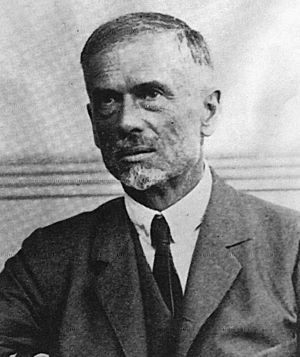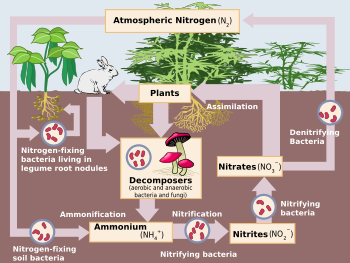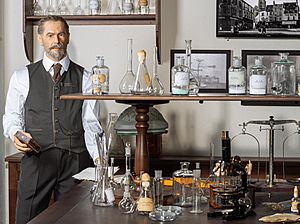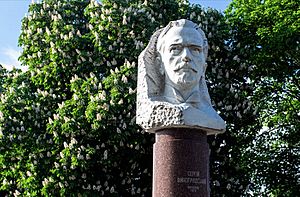Sergei Winogradsky facts for kids
Quick facts for kids
Sergei Winogradsky
|
|
|---|---|
 |
|
| Born | 1 September 1856 |
| Died | February 25, 1953 (aged 96) Brie-Comte-Robert, France
|
| Alma mater | University of Saint Petersburg |
| Known for | Nitrogen cycle Chemoautotrophy Sulfur-oxidizing bacteria |
| Awards | Leeuwenhoek Medal (1935) Fellow of the Royal Society |
| Scientific career | |
| Fields | Microbiology |
| Institutions | Imperial Conservatoire of Music in St Petersburg (piano) University of Saint Petersburg University of Strasbourg Pasteur Institute |
| Influences | Anton de Bary Nikolai Menshutkin (chemistry) Andrei Famintsyn (botany) Martinus Beijerinck |
| Influenced | Selman Waksman Martinus Beijerinck Vasily Leonidovitch Omelianski |
| Signature | |
Sergei Nikolaievich Winogradsky (born September 1, 1856 – died February 25, 1953) was a Ukrainian microbiologist and soil scientist. He was a pioneer in understanding how living things recycle important elements on Earth. This is called the cycle-of-life concept.
Winogradsky made a big discovery in 1887. He found the first known type of lithotrophy. This is when tiny organisms get energy from inorganic (non-living) chemicals. He studied bacteria called Beggiatoa. He saw that Beggiatoa used hydrogen sulfide (a gas that smells like rotten eggs) for energy. They even stored sulfur inside their cells. This was the first time anyone saw an organism get energy this way.
Later, he studied nitrifying bacteria. He discovered chemoautotrophy. This is a process where organisms use chemical energy to make their own food. They take carbon dioxide (CO2) from the air and turn it into organic compounds.
He is also famous for inventing the Winogradsky column. This is a simple way to study different types of microbes in mud and water.
Contents
About Sergei Winogradsky
Winogradsky was born in Kyiv, which was part of the Russian Empire at the time. His family was wealthy.
Early Life and Education
After finishing high school in 1873, he first studied law. But he soon changed his mind. In 1875, he went to the Saint Petersburg Conservatory to study piano. He loved music, but after two years, he decided to study science instead.
In 1877, he joined the University of Saint Petersburg. There, he studied chemistry and botany. He earned his first degree in 1881. Then, he continued his studies and got a Master of Science degree in botany in 1884.
Scientific Career and Discoveries
In 1885, Winogradsky started working at the University of Strasbourg. He worked with a famous botanist named Anton de Bary. Winogradsky quickly became known for his important work on sulfur bacteria.
In 1888, he moved to Zurich. There, he began to study nitrification. This is a process where bacteria change nitrogen compounds in the soil. He found two types of bacteria: Nitrosomonas and Nitrosococcus. These bacteria turn ammonium into nitrite. He also found Nitrobacter, which turns nitrite into nitrate. These steps are key parts of the Nitrogen cycle.
From 1891 to 1905, he worked in St. Petersburg. He led the general microbiology section at the Institute of Experimental Medicine. During this time, he found a special type of bacteria called Clostridium pasteurianum. This bacteria can take nitrogen gas from the air and turn it into a form plants can use. It does this without needing to live inside plant roots. He also taught his only student, Vasily Leonidovitch Omelianski. Vasily helped spread Winogradsky's ideas in the Soviet Union.
In 1905, Winogradsky left the institute due to health reasons. He moved to his large estate in Horodok. There, he focused on farming and soil science. He used new methods and technology to make his farm very successful.
After the 1917 revolution, Winogradsky moved to Switzerland and then to Belgrade. In 1922, he was invited to lead a new section at the Pasteur Institute in France. He worked on many topics there. These included iron bacteria, nitrogen fixation by Azotobacter, and bacteria that break down cellulose. He retired in 1940 and passed away in 1953.
Key Discoveries
Winogradsky made several major discoveries about how elements cycle in nature.
- Sulfur Cycle: He showed how bacteria use sulfur compounds for energy. This included his discovery of lithotrophy in Beggiatoa.
- Nitrogen Cycle: He found Clostridium pasteurianum, a free-living microbe that can take nitrogen from the air.
- Chemosynthesis: This was one of his most important discoveries.
- Winogradsky Column: He invented this simple tool to study microbes.

Chemosynthesis Explained
Winogradsky is most famous for discovering chemoautotrophy, also known as chemosynthesis. This is how some organisms get energy from different inorganic compounds. They also get carbon from carbon dioxide to make their own food.
Before Winogradsky, scientists thought that organisms that make their own food (autotrophs) only got energy from light. But he showed that some organisms can get energy from chemical reactions. For example, they can use compounds like hydrogen sulfide or ammonium. This led to dividing autotrophs into two groups: photoautotrophs (using light) and chemoautotrophs (using chemicals).
Winogradsky was one of the first scientists to study tiny organisms (microorganisms) outside of their role in medicine. This made him a founder of microbial ecology. This field studies how microbes live in their natural environments.
The Winogradsky column is still used today. It helps show how chemoautotrophy and microbial ecology work.
See also
- Hermann Hellriegel
- Martinus Beijerinck
Memorials
A school in Ukraine, Ukrainian: : Виноградський ліцей, is named after him. It is located in Vynohrad, Ivano-Frankivsk Oblast.
In 2012, a monument to Sergei Winogradsky was built in Horodok, Ukraine.
Study of His Life and Work
There is a special group called the Winogradsky Club. It helps people learn more about Sergei Winogradsky's life and work. The main center for this club is in Horodok, Ukraine. It is part of the G-Museum.
The G-Museum has a special exhibit. It is a copy of Winogradsky's laboratory from France. It even has a wax figure of the scientist. Winogradsky lived in Horodok from 1905 to 1916. He worked on new farming ideas there, which helped the area become more prosperous.



